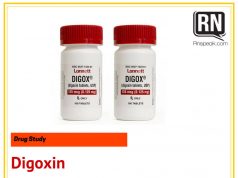
Generic Name: Diclofenac Sodium
Brand Name: Voltaren, Voltaren-XR
Classifications:central nervous system agent; nsaid; analgesic; nonnarcotic;antipyretic
Pregnancy Category:B
Availability
25 mg, 50 mg, 75 mg tablets; 100 mg sustained release tablets; 0.1% ophthalmic solution; 3% gel; 50 mg tablets
Actions
Although its exact mechanism of action has not been fully elucidated, it appears to be a potent inhibitor of cyclooxygenase, thereby decreasing the synthesis of prostaglandins.
Therapeutic effects
Nonsteroidal antiinflammatory drug (NSAID) with analgesic and antipyretic activity.
Uses
Analgesic and antipyretic effects in symptomatic treatment of rheumatoid arthritis, osteoarthritis, and ankylosing spondylitis. Also acute gout; juvenile rheumatoid arthritis; various rheumatic conditions including bursitis, myalgia, sciatica, and tendinitis; acute soft tissue injuries including sprains and strains; dysmenorrhea; headache, migraine, and dental, minor surgical, and postpartum pain; and renal or biliary colic. Ophthalmic: Cataract surgery; photophobia associated with refractive surgery. Topical Treatment of actinic keratosis
Contraindicatons
Hypersensitivity to diclofenac, patients in whom asthma, urticaria, angioedema, bronchospasm, severe rhinitis, shock, or other sensitivity reaction is precipitated by aspirin or other NSAIDS, pregnancy (category B), lactation.
Cautious use
Geriatric patients and children; patients receiving anticoagulant therapy; history of GI disease; GU tract problems such as dysuria, cystitis, hematuria, nephritis, nephrotic syndrome, patients who must restrict their sodium intake; impaired hepatic function; SLE; heart failure; hypertension.
Route & Dosage
Rheumatoid Arthritis
adult:PO 150–200 mg/d in 3–4 divided doses
child:PO 25 mg b.i.d. or t.i.d.
Osteoarthritis
adult:PO 100–150 mg/d in 3–4 divided doses 100 mg sustained release q.d.
Ankylosing Spondylitis
adult:PO 25 mg q.i.d. and 25 mg h.s.
Cataract Surgery
adult:Ophthalmic 1 drop of 0.1% solution in affected eye q.i.d. beginning 24 h after surgery and continuing for 2 wk
Actinic Keratosis
adult:Topical apply to affected area b.i.d. for 60–90 d.
Administration
Oral
- Ensure that sustained release or enteric coated forms of drug are not chewed or crushed. MUST be swallowed whole.
- Give on an empty stomach, 1 h before or after a meal; absorption is delayed markedly by food. Minimize gastric irritation by administering it with a full glass of milk or water.
- Schedule administration 30 min before physical therapy or planned exercise to keep discomfort at a minimum.
- Discontinue therapy about 1 wk before surgery to reduce risk of bleeding.
- Use with caution in anyone who must restrict sodium intake.
- Store at 15°–30° C (59°–86° F) away from heat and direct light.
Adverse effects
CNS:Dizziness,headache, drowsiness.
SpecSenses:Tinnitus.
Skin:Rash, pruritus.
GI:Dyspepsia, nausea, vomiting, abdominal pain, cramps, constipation, diarrhea, indigestion, abdominal distension, flatulence, peptic ulcer; liver enzymes, transaminases increased, liver test abnormalities.
CV:Fluid retention, hypertension, CHF.
Respiratory:Asthma.
BodyWhole:Back,leg, or joint pain.
Endocrine:Hyperglycemia.
Hematologic:Prolonged bleeding time; inhibits platelet aggregation.
Nursing implications
Assessment & Drug Effects
- Monitor for therapeutic effectiveness. Up to 3 wks may be need for beneficial effects with rheumatoid arthritis or osteoarthritis.
- Lab tests: Periodic liver function, serum uric acid concentrations Hct, PT/INR, and bloodglucose.
- Observe and report signs of bleeding (e.g., petechiae, ecchymoses, bleeding gums, bloody or black stools, cloudy or bloody urine).
- Monitor BP for hypertension and blood sugar for hyperglycemia.
- Monitor diabetics closely for loss of diabetic control.
- Monitor for increased serum sodium and potassium in patients receiving potassium-sparing diuretics.
- Monitor weight and report gains greater than 1 kg (2 lb)/24 h.
- Monitor for signs and symptoms of GI irritation and ulceration.
Patient & Family Education
Oral Form
- Do not lie down for 15–30 min after taking medicine to decrease esophageal irritation.
- Discontinue use with onset of ringing or buzzing in the ears, impaired hearing, dizziness, GI discomfort, or bleeding and notify physician.
- Do not take aspirin or other OTC analgesics without permission of the physician.
- Avoid alcohol or other CNS depressants.
- Do not drive or engage in other potentially hazardous activities until reaction to drug is known.
- Note: Diabetics need to monitor blood glucose carefully for loss of glycemic control.
- Do not breast feed while taking this drug.







